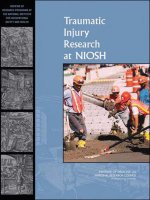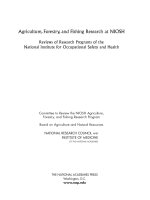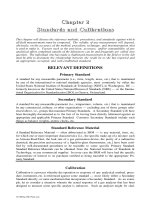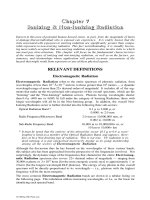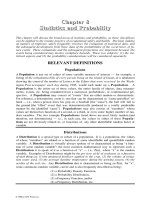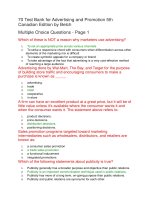Occupational safety and health for technologist engineers and managers 8th global edition by gotsch
Bạn đang xem bản rút gọn của tài liệu. Xem và tải ngay bản đầy đủ của tài liệu tại đây (26.53 MB, 715 trang )
Occupational Safety and Health
For Technologists, Engineers, and Managers
For these Global Editions, the editorial team at Pearson has
collaborated with educators across the world to address a wide range
of subjects and requirements, equipping students with the best possible
learning tools. This Global Edition preserves the cutting-edge approach
and pedagogy of the original, but also features alterations, customization,
and adaptation from the North American version.
Global
edition
Global
edition
Global
edition
Occupational Safety
and Health
For Technologists, Engineers, and Managers
EIGHTH edition
EIGHTH edition
Goetsch
This is a special edition of an established title widely
used by colleges and universities throughout the world.
Pearson published this exclusive edition for the benefit
of students outside the United States and Canada. If you
purchased this book within the United States or Canada
you should be aware that it has been imported without
the approval of the Publisher or Author.
David L. Goetsch
Pearson Global Edition
Goetsch_1292061995_mech.indd 1
12/06/14 8:53 AM
A01_GOET1993_08_GE_FM.indd Page 1 17/05/14 2:26 PM user
/205/PH01353_GE/9781292061993_GOETSCH/GOETSCH_OCCUPATIONAL_SAFETY_AND_HEALTH_FOR_
Occupational Safety
and Health
For Technologists, Engineers, and Managers
A01_GOET1993_08_GE_FM.indd Page 2 17/05/14 2:26 PM user
/205/PH01353_GE/9781292061993_GOETSCH/GOETSCH_OCCUPATIONAL_SAFETY_AND_HEALTH_FOR_
This page is intentionally left blank.
A01_GOET1993_08_GE_FM.indd Page 3 17/05/14 2:26 PM user
/205/PH01353_GE/9781292061993_GOETSCH/GOETSCH_OCCUPATIONAL_SAFETY_AND_HEALTH_FOR_
Occupational Safety
and Health
For Technologists, Engineers, and Managers
Eighth Edition
Global Edition
David L. Goetsch
Vice-President Emeritus and Professor
Northwest Florida State College
Boston Columbus Indianapolis New York San Francisco Upper Saddle River
Amsterdam Cape Town Dubai London Madrid Milan Munich Paris Montreal Toronto
Delhi Mexico City São Paolo Sydney Hong Kong Seoul Singapore Taipei Tokyo
A01_GOET1993_08_GE_FM.indd Page 4 23/06/14 6:21 PM user
/205/PH01353_GE/9781292061993_GOETSCH/GOETSCH_OCCUPATIONAL_SAFETY_AND_HEALTH_FOR_
Editorial Director: Vernon R. Anthony
Head of Learning Asset Acquisition, Global Edition: Laura Dent
Senior Acquisitions Editor: Lindsey Gill
Editorial Assistant: Nancy Kesterson
Director of Marketing: David Gesell
Senior Marketing Coordinator: Alicia Wozniak
Marketing Assistant: Les Roberts
Program Manager: Maren L. Beckman
Project Manager: Janet Portisch
Acquisitions Editor, Global Edition: Vrinda Malik
Associate Project Editor, Global Edition: Uttaran Das Gupta
Procurement Specialist: Deidra M. Skahill
Senior Manufacturing Controller, Production, Global Edition: Trudy Kimber
Senior Art Director: Diane Ernsberger
Cover Designer: Lumina Datamatics
Cover Image: © Luiz Rocha/Shutterstock
Manager, Rights and Permissions: Mike Lackey
Media Director: Leslie Brado
Lead Media Project Manager: April Cleland
Full-Service Project Management: Jogender Taneja, Aptara®, Inc.
Credits and acknowledgments borrowed from other sources and reproduced, with permission, in this textbook
appear on the appropriate page within text.
Pearson Education Limited
Edinburgh Gate
Harlow
Essex CM 20 2JE
England
and Associated Companies throughout the world
Visit us on the World Wide Web at:
www.pearsonglobaleditions.com
© Pearson Education Limited 2015
The rights of David L. Goetsch to be identified as the author of this work have been asserted by him in
accordance with the Copyright, Designs and Patents Act 1988.
Authorized adaptation from the United States edition, entitled Occupational Safety and Health: For
Technologists, Engineers, and Managers, 8th edition, ISBN 978-0-133-48417-5, by David L. Goetsch, published
by Pearson Education © 2015.
All rights reserved. No part of this publication may be reproduced, stored in a retrieval system, or transmitted
in any form or by any means, electronic, mechanical, photocopying, recording or otherwise, without either
the prior written permission of the publisher or a license permitting restricted copying in the United Kingdom
issued by the Copyright Licensing Agency Ltd, Saffron House, 6–10 Kirby Street, London EC1N 8TS.
All trademarks used herein are the property of their respective owners. The use of any trademark in this text
does not vest in the author or publisher any trademark ownership rights in such trademarks, nor does the use
of such trademarks imply any affiliation with or endorsement of this book by such owners.
ISBN 10: 1-292-06199-5
ISBN 13: 978-1-292-06199-3 (Print)
ISBN 13: 978-1-292-06216-7 (PDF)
British Library Cataloguing-in-Publication Data
A catalogue record for this book is available from the British Library
10 9 8 7 6 5 4 3 2 1
14 13 12 11
Typeset by Aptara®, Inc. in Melior 10 pt.
Printed and bound by Courier Kendallville in The United States of America.
A01_GOET1993_08_GE_FM.indd Page 5 17/05/14 2:26 PM user
/205/PH01353_GE/9781292061993_GOETSCH/GOETSCH_OCCUPATIONAL_SAFETY_AND_HEALTH_FOR_
Preface
Background
The field of occupational safety and health has undergone significant change over the
past three decades. There are many reasons for this. Some of the more prominent reasons include the following: technological changes that have introduced new hazards in
the workplace; proliferation of health and safety legislation and corresponding regulations;
increased pressure from regulatory agencies; realization by executives that workers in a
safe and healthy workplace are typically more productive; health care and workers’ compensation cost increases; increased pressure from environmental groups and the public; a
growing interest in ethics and corporate responsibility; professionalization of health and
safety occupations; increased pressure from labor organizations and employees in general;
rapidly mounting costs associated with product safety and other types of litigation; and
increasing incidents of workplace violence.
All of these factors, when combined, have made the job of the modern safety and health
professional more challenging and more important than it has ever been. These factors have also
created a need for an up-to-date book on workplace safety and health that contains the latest
information needed by people who will practice this profession in an age of global competition
and rapid technological change.
Why Was This Book Written and for Whom?
This book was written to fulfill the need for an up-to-date, practical teaching resource that
focuses on the needs of modern safety and health professionals practicing in the workplace.
It is intended for use in universities, colleges, community colleges, and corporate training
settings that offer programs, courses, workshops, and seminars in occupational safety and
health. Educators in such disciplines as industrial technology, manufacturing technology,
industrial engineering, engineering technology, occupational safety, management, and supervision will find this book both valuable and easy to use. The direct, straightforward
presentation of material focuses on making the theories and principles of occupational
safety and health practical and useful in a real-world setting. Up-to-date research has been
integrated throughout in a down-to-earth manner.
Organization of the Book
The text contains 31 chapters organized into 5 parts, each focusing on a major area of concern for modern safety and health professionals. The chapters are presented in an order
that is compatible with the typical organization of a college-level safety and health course.
A standard chapter format is used throughout the book. Each chapter begins with a list
of major topics and ends with a comprehensive summary. Following the summary, most
chapters include review questions, key terms and concepts, and endnotes. Within each
chapter are case studies to promote classroom discussion, as well as at least one safety fact
or myth. These materials are provided to encourage review, stimulate additional thought,
and provide opportunities for applying what has been learned.
Supplements
To access supplementary materials online, instructors need to request an instructor
access code. Go to www.pearsonglobaledition.com/Goetsch to register for an instructor
access code. Within 48 hours of registering, you will receive a confirming e-mail including an instructor access code. Once you have received your code, locate your text in the
5
A01_GOET1993_08_GE_FM.indd Page 6 17/05/14 2:26 PM user
6
/205/PH01353_GE/9781292061993_GOETSCH/GOETSCH_OCCUPATIONAL_SAFETY_AND_HEALTH_FOR_
Preface
nline catalog and click on the Instructor Resources button on the left side of the catalog
o
product page. Select a supplement, and a login page will appear. Once you have logged
in, you can access instructor material for all Pearson textbooks. If you have any difficulties accessing the site or downloading a supplement, please contact Customer Service at
/>
How This Book Differs from Others
This book was written because in the age of global competition, safety and health in the
workplace have changed drastically. Many issues, concerns, and factors relating specifically to modern workplace environments have been given more attention, greater depth
of coverage, and more illumination here than other textbooks. Some of the areas receiving
more attention and specific occupational examples include:
■
■
■
■
■
■
■
■
■
■
■
■
■
■
■
■
■
■
■
■
■
■
The Occupational Safety and Health Act (OSH Act) and Occupational Safety and
Health Administration (OSHA)
Standards and codes
Laws and liability
Stress-related problems
Life safety and fire hazards
The evolving roles of health and safety professionals
Health and safety training
Human factors in safety
Environmental issues and ISO 14000 standards
Computers, robots, and automation
Ethics and safety
Bloodborne pathogens in the workplace
MRSA in the workplace
Product safety and liability
Ergonomics and safety
The relationship between safety and quality
Workplace violence
Workers’ compensation
Repetitive strain injuries (RSIs)
Terrorism threats in the workplace
Safety-first corporate culture
Off-the-job safety
New to This Edition
The eighth edition of Occupational Safety and Health is a major revision encompassing
new regulations, revised regulations, and other new and updated material of importance to
students of occupational safety and health. Specifically, the following revisions were made
in the eighth edition:
■
■
■
Chapter 1: New section covering the Return on Investment (ROI) in safety and
health management was added as was a new example case about a factory fire in
Bangladesh.
Chapter 2: The section Death Rates by Industry was updated.
Chapter 3: New material was added on Heinrich’s theory and corrective action and on
the limitations of event-chain accident causation theories.
A01_GOET1993_08_GE_FM.indd Page 7 17/05/14 2:26 PM user
/205/PH01353_GE/9781292061993_GOETSCH/GOETSCH_OCCUPATIONAL_SAFETY_AND_HEALTH_FOR_
Preface
7
■
■
■
■
■
■
■
■
■
■
■
Chapter 6: This chapter was re-written to reflect changes to OSHA standards that have
occurred since the seventh edition. Revisions made include a re-write of: OSHA’s
mission; coverage of federal, state, and local government personnel; how OSHA
standards are developed; workplace inspection priorities; OSHA’s whistleblower program; OSHA’s severe violator enforcement program; OSHA assistance, services, and
programs; and the section on OSHA’s Maritime Standard. In addition, a new section
on OSHA’s stand on safety incentives was added.
Chapter 7: Added material clarifying explaining when employees covered by Workers’ Compensation can and cannot sue.
Chapter 8: Added new material on the what and why of workplace accidents, the latest version of OSHA’s Form 301, the team approach to accident investigations, how
to add perspective to accident scene photographs, and how to follow-up an accident
investigation.
Chapter 10: Added new material on the repeal of OSHA’s short-lived Ergonomic Program Standard and updated the statistics on the extent of MSDs and CTDs.
Chapter 14: Added new material on minimum general requirements for machine safeguards. Added a new section titled “Permanent Electrical Safety Devices in Lockout/
Tagout Programs.”
Chapter 15: Added new material on the new ANSI/NFSI B101.1 Standard for measuring
wet SCOF traction, OSHA’s Fall Protection Standard, and head protection (rating of hard
hats). Added a new section titled “OSHA’s Fall Protection Standard for Construction.”
Chapter 16: Added material on PPE for cold work environments.
Chapter 18: Updated and expanded the “Electrical Hazards Self-Assessment.” Added
a new section titled “Permanent Electrical Safety Devices.”
Chapter 19: Added new material on flammable and combustible liquids.
Chapter 20: Updated OSHA’s Process Safety Management Guidelines and the section
on Material Safety Data Sheets or MSDS (now Safety Data Sheets or SDS) and Global
Harmonization of Hazard Communication (GHS). Added a new list of standards for
Indoor Air Quality (IAQ) investigations and new sections titled “ASTM D7338: Guide
for the Assessment of Fungal Growth in Buildings,” “OSHA’s Chemical Process
Standard,” “Environment Protection Agency (EPA) Risk Management Program,” “Hazardous Materials Transportation Act (HMTA),” “OSHA Confined Space Standard,”
and “Nanoscale Materials and Industrial Hygiene.”
Chapter 22: Added new material on fit testing and a new section titled “Future of
Hearing Conservation: Noise Reduction Rating.”
About the Author
David L. Goetsch is Vice-President Emeritus of Northwest Florida State College and professor of safety, quality, and environmental management. In addition, Dr. Goetsch is
president and CEO of the Institute for Organizational Excellence (IOE), a private consulting firm dedicated to the continual improvement of organizational competitiveness,
safety, and quality. Dr. Goetsch is cofounder of The Quality Institute, a partnership of the
University of West Florida, Northwest Florida State College, and the Okaloosa Economic
Development Council.
A01_GOET1993_08_GE_FM.indd Page 8 17/05/14 2:26 PM user
8
/205/PH01353_GE/9781292061993_GOETSCH/GOETSCH_OCCUPATIONAL_SAFETY_AND_HEALTH_FOR_
Preface
Acknowledgments
The author acknowledges the invaluable assistance of the following people in developing
this book: Dr. Lissa Galbraith, Florida A&M/Florida State University, for the material she
contributed on electrical and fire hazards in the first edition; Harvey Martin, health and
safety manager of Metric Systems Corporation in Fort Walton Beach, Florida, for providing
up-to-date research material; and the following reviewers for their invaluable input: Steven
A. Freeman—Iowa State University; JoDell K. Steuver—Purdue University; and Ottis E.
Walizer—Minot State University. Special acknowledgment goes to Larry D. Leiman for his
contributions in updating all OSHA standards.
Pearson would like to thank and acknowledge the following persons for their contributions
to the Global Edition:
Contributors: Mohd Saidin Misnan, Universiti Teknologi Malaysia, Johor; and Vipin
Sharma
Reviewers: Tushar Kant Joshi, director of occupational medical program, Centre for
Occupational and Environmental Health, Maulana Azad Medical College, New Delhi;
Arvind Kumar, National Institute of Technology, Rourkela; B. Suresh, Bapuji Institute of
Engineering and Technology, Davangere, Karnataka.
A01_GOET1993_08_GE_FM.indd Page 9 17/05/14 2:26 PM user
/205/PH01353_GE/9781292061993_GOETSCH/GOETSCH_OCCUPATIONAL_SAFETY_AND_HEALTH_FOR_
Introduction
Safety versus Health
The title of this book intentionally includes the words safety and health. Throughout the
text, the titles “safety and health professional” and “safety and health manager” are used.
This, too, is done by design. This approach underscores the point that the field of occupational safety has been broadened to encompass both safety and health. Consequently,
managers, technical personnel, and engineers in this field must be knowledgeable about
safety and health and be prepared to oversee a corporate program that encompasses both
areas of responsibility.
Safety and health, although closely related, are not the same. One view is that safety
is concerned with injury-causing situations, whereas health is concerned with disease-
causing conditions. Another view is that safety is concerned with hazards to humans that
result from sudden severe conditions; health deals with adverse reactions to exposure to
dangerous, but less intense, hazards. Both of these views are generally accurate in portraying the difference between safety and health. However, the line between these two concepts is not always clearly marked.
For example, on the one hand, stress is a hazard that can cause both psychological and
physiological problems over a prolonged period. In this case, it is a health concern. On the
other hand, an overly stressed worker may be more prone to unintentionally forget safety
precautions and thus may cause an accident. In this case, stress is a safety concern.
Because managers in this evolving profession are likely to be responsible for safety and
health, it is important that they have a broad academic background covering both. This
book attempts to provide that background.
This broadening of the scope of the profession does not mean that specialists in safety
and health are not still needed. They are. Chapter 4 shows how today’s safety and health
manager is a generalist who often heads a team of specialists such as safety engineers,
health physicists, industrial hygienists, occupational nurses, occupational physicians,
and risk managers. In order to manage a team of specialists in these various areas, safety
and health managers must have the broad and comprehensive background that this book
provides.
9
A01_GOET1993_08_GE_FM.indd Page 10 17/05/14 2:26 PM user
/205/PH01353_GE/9781292061993_GOETSCH/GOETSCH_OCCUPATIONAL_SAFETY_AND_HEALTH_FOR_
This page is intentionally left blank.
A01_GOET1993_08_GE_FM.indd Page 11 17/05/14 2:26 PM user
/205/PH01353_GE/9781292061993_GOETSCH/GOETSCH_OCCUPATIONAL_SAFETY_AND_HEALTH_FOR_
Brief Contents
Part 1 Historical Perspective and Overview 23
1 Safety and Health Movement, Then and Now 25
2Accidents and Their Effects 41
3Theories of Accident Causation 55
4Roles and Professional Certifications for Safety and Health Professionals 74
5 Safety, Health, and Competition in the Global Marketplace 97
Part 2 Laws and Regulations 105
6The OSH Act, Standards, and Liability 107
7Workers’ Compensation 157
8Accident Investigation and Reporting 183
9Product Safety and Liability 200
Part 3 The Human Element 215
10Ergonomic Hazards: Musculoskeletal Disorders (MSDs) and Cumulative Trauma
Disorders (CTDs) 217
11 Stress and Safety 248
12 Safety and Health Training 259
13Violence in the Workplace 288
Part 4 Hazard Assessment, Prevention, and Control 303
14 Mechanical Hazards and Machine Safeguarding 305
15Falling, Impact, Acceleration, Lifting, and Vision Hazards with Appropriate PPE 325
16 Hazards of Temperature Extremes 357
11
A01_GOET1993_08_GE_FM.indd Page 12 17/05/14 2:26 PM user
12
/205/PH01353_GE/9781292061993_GOETSCH/GOETSCH_OCCUPATIONAL_SAFETY_AND_HEALTH_FOR_
Brief Contents
17Pressure Hazards 371
18Electrical Hazards 384
19Fire Hazards and Life Safety 403
20Industrial Hygiene and Confined Spaces 429
21Radiation Hazards 471
22Noise and Vibration Hazards 487
23Computers, Automation, and Robots 512
24 Bloodborne Pathogens and Bacterial Hazards in the Workplace 524
Part 5 Management of Safety and Health 545
25Preparing for Emergencies and Terrorism 547
26Ethics and Safety 571
27 Hazard Analysis/Prevention and Safety Management 584
28Promoting Safety 606
29Environmental Safety and ISO 14000 (Environmental Management) 623
30TSM: Total Safety Management in a Quality Management Setting 651
31Establishing a Safety-First Corporate Culture 664
A01_GOET1993_08_GE_FM.indd Page 13 17/05/14 2:26 PM user
/205/PH01353_GE/9781292061993_GOETSCH/GOETSCH_OCCUPATIONAL_SAFETY_AND_HEALTH_FOR_
Contents
Part 1 Historical Perspective and Overview 23
1 Safety and Health Movement, Then and Now 25
Developments Before the Industrial Revolution 25
Milestones in the Safety Movement 26
Tragedies That Have Changed the Safety Movement 29
Role of Organized Labor 31
Role of Specific Health Problems 31
Development of Accident Prevention Programs 33
Development of Safety Organizations 34
Safety and Health Movement Today 36
Integrated Approach to Safety and Health 36
New Materials, New Processes, and New Problems 37
Rapid Growth in the Profession 37
Return on Investment in Safety and Health Management 37
2Accidents and Their Effects 41
Costs of Accidents 42
Accidental Deaths in the United States 42
Accidents versus Other Causes of Death 43
Work Accident Costs and Rates 44
Time Lost Because of Work Injuries 44
Deaths in Work Accidents 44
Work Injuries by Type of Accident 45
Death Rates by Industry 45
Parts of the Body Injured on the Job 46
Chemical Burn Injuries 47
Heat Burn Injuries 47
Repetitive Strain/Soft Tissue Injuries 48
Estimating the Cost of Accidents 49
Global Impact of Accidents and Injuries 51
3Theories of Accident Causation 55
Domino Theory of Accident Causation 55
Human Factors Theory of Accident Causation 58
Accident/Incident Theory of Accident Causation 60
Epidemiological Theory of Accident Causation 62
Systems Theory of Accident Causation 63
Combination Theory of Accident Causation 66
13
A01_GOET1993_08_GE_FM.indd Page 14 17/05/14 2:26 PM user
14
/205/PH01353_GE/9781292061993_GOETSCH/GOETSCH_OCCUPATIONAL_SAFETY_AND_HEALTH_FOR_
Contents
Behavioral Theory of Accident Causation 67
Drugs and Accident Causation 68
Depression and Accident Causation 68
Management Failures and Accident Causation 69
Obesity and Accident Causation 70
4Roles and Professional Certifications for Safety
and Health Professionals 74
Modern Safety and Health Teams 74
Safety and Health Manager 75
Engineers and Safety 82
Industrial Hygienist 87
Health Physicist 87
Occupational Physician 87
Occupational Health Nurse 88
Risk Manager 89
Certification of Safety and Health Professionals 90
Emerging Role of Safety Professionals 94
5 Safety, Health, and Competition in the Global Marketplace 97
Competitiveness Defined 97
Productivity and Competitiveness 99
Quality and Competitiveness 100
How Safety and Health Can Improve Competitiveness 101
Part 2 laws and Regulations 105
6The OSH Act, Standards, and Liability 107
Rationale for the OSH Act 108
OSHA’s Mission and Purpose 108
OSH Act Coverage 109
OSHA Standards 110
OSHA’s Record Keeping and Reporting 115
Keeping Employees Informed 122
Workplace Inspections and Enforcement 122
OSHA’S Whistleblower Program 123
OSHA’s Enhanced Enforcement Policy 124
Citations and Penalties 125
Appeals Process 126
State-Level OSHA Programs 127
Services Available from OSHA 128
Employer Rights and Responsibilities 131
Employee Rights and Responsibilities 133
Keeping Up-to-Date on OSHA 134
Problems with OSHA 134
A01_GOET1993_08_GE_FM.indd Page 15 17/05/14 2:26 PM user
/205/PH01353_GE/9781292061993_GOETSCH/GOETSCH_OCCUPATIONAL_SAFETY_AND_HEALTH_FOR_
Contents
15
Other Agencies and Organizations 135
OSHA’s General Industry Standards 139
OSHA’s Maritime Standards 146
OSHA’s Construction Standards 147
Standards and Codes 148
Laws and Liability 150
OSHA’S Stand on Safety Incentives 152
7Workers’ Compensation 157
Overview of Workers’ Compensation 157
Historical Perspective 159
Workers’ Compensation Legislation 161
Modern Workers’ Compensation 161
Workers’ Compensation Insurance 163
Resolution of Workers’ Compensation Disputes 164
Injuries and Workers’ Compensation 165
Disabilities and Workers’ Compensation 166
Monetary Benefits of Workers’ Compensation 170
Medical Treatment and Rehabilitation 171
Medical Management of Workplace Injuries 172
Administration and Case Management 173
Cost Allocation 173
Problems with Workers’ Compensation 174
Spotting Workers’ Compensation Fraud and Abuse 175
Future of Workers’ Compensation 175
Cost-Reduction Strategies 176
8Accident Investigation and Reporting 183
Types of Accident Investigations 183
When to Investigate 185
What to Investigate 185
Who Should Investigate 187
Conducting the Investigation 188
Interviewing Witnesses 190
Reporting Accidents 192
Ten Accident Investigation Mistakes to Avoid 196
9Product Safety and Liability 200
Product Liability and the Law 200
Developing a Product Safety Program 204
Evaluating the Product Safety Program 205
Role of the Safety and Health Professional 206
Quality Management and Product Safety 207
Product Safety Program Record Keeping 209
User Feedback Collection and Analysis 210
A01_GOET1993_08_GE_FM.indd Page 16 17/05/14 2:26 PM user
16
/205/PH01353_GE/9781292061993_GOETSCH/GOETSCH_OCCUPATIONAL_SAFETY_AND_HEALTH_FOR_
Contents
Product Literature and Safety 210
Product Recalls and Safety Professionals 211
Part 3 The Human Element 215
10Ergonomic Hazards: Musculoskeletal Disorders (MSDs) and Cumulative
Trauma Disorders (CTDs) 217
Ergonomics Defined 218
Human Factors and Ergonomic Hazards 218
Factors Associated with Physical Stress 219
Ergonomics: A Political Football 221
OSHA’s Voluntary Ergonomics Guidelines 222
Worksite Analysis Program for Ergonomics 225
Hazard Prevention and Control 228
Medical Management Program 229
Training and Education 232
Common Indicators of Problems 232
Identifying Specific Ergonomic Problems 233
Ergonomic Problem-Solving Strategies 235
Economics of Ergonomics 240
Cumulative Trauma Disorders 241
Participatory Ergonomics 244
11 Stress and Safety 248
Workplace Stress Defined 248
Sources of Workplace Stress 249
Human Reactions to Workplace Stress 251
Measurement of Workplace Stress 252
Shift Work, Stress, and Safety 252
Improving Safety by Reducing Workplace Stress 253
Stress in Safety Managers 255
Stress and Workers’ Compensation 256
12 Safety and Health Training 259
Rationale for Safety and Health Training 259
Education and Training Requirements 262
Safety and Health Professionals as Trainers 265
Preparing Safety and Health Instruction 267
Presenting Safety and Health Instruction 268
Applying Safety and Health Instruction 273
Evaluating Safety and Health Instruction 274
Training Supervisors 275
Training New and Transferred Employees 275
Job Safety Analysis as a Training Technique 278
Training Opportunities Available 280
A01_GOET1993_08_GE_FM.indd Page 17 17/05/14 2:26 PM user
/205/PH01353_GE/9781292061993_GOETSCH/GOETSCH_OCCUPATIONAL_SAFETY_AND_HEALTH_FOR_
Contents
17
Illiteracy and Safety 281
English as a Second Language Training Issues 284
OSHA Standards and Training 284
13Violence in the Workplace 288
Occupational Safety and Workplace Violence: The Relationship 288
Workplace Violence: Definitions 288
Legal Considerations 289
Risk-Reduction Strategies 291
OSHA’s Voluntary Guidelines on Workplace Violence 292
Do’s and Don’ts for Supervisors 300
Emergency Preparedness Plan 300
Part 4 Hazard Assessment, Prevention, and Control 303
14 Mechanical Hazards and Machine Safeguarding 305
Common Mechanical Injuries 305
Safeguarding Defined 308
OSHA’s Requirements for Machine Guarding 308
Risk Assessment in Machine Operation 309
Design Requirements for Safeguards 310
Point-of-Operation Guards 311
Point-of-Operation Devices 313
Machine Guarding Self-Assessment 314
Feeding and Ejection Systems 315
Robot Safeguards 315
Control of Hazardous Energy (Lockout/Tagout Systems) 316
Permanent Electrical Safety Devices in Lockout/Tagout Programs 317
General Precautions 321
Basic Program Content 321
Taking Corrective Action 322
15Falling, Impact, Acceleration, Lifting, and Vision Hazards with
Appropriate PPE 325
Causes of Falls 325
Kinds of Falls 326
Walking and Slipping 326
Slip and Fall Prevention Programs 329
OSHA Fall Protection Standards 330
Ladder Safety 333
What to Do after a Fall 335
Monitor Fall Protection Equipment and Know Why It Fails 335
Impact and Acceleration Hazards 335
Lifting Hazards 342
Standing Hazards 345
A01_GOET1993_08_GE_FM.indd Page 18 17/05/14 2:26 PM user
18
/205/PH01353_GE/9781292061993_GOETSCH/GOETSCH_OCCUPATIONAL_SAFETY_AND_HEALTH_FOR_
Contents
Hand Protection 346
Personal Protective Equipment 349
Forklift Safety (Powered Industrial Trucks) 351
16 Hazards of Temperature Extremes 357
Thermal Comfort 357
Heat Stress and Strain 358
Cold Stress 361
Burns and Their Effects 364
Chemical Burns 367
17Pressure Hazards 371
Pressure Hazards Defined 371
Sources of Pressure Hazards 372
Boilers and Pressure Hazards 373
High-Temperature Water Hazards 373
Hazards of Unfired Pressure Vessels 374
Hazards of High-Pressure Systems 374
Cracking Hazards in Pressure Vessels 374
Nondestructive Testing of Pressure Vessels 376
Pressure Dangers to Humans 376
Decompression Procedures 378
Measurement of Pressure Hazards 378
Reduction of Pressure Hazards 379
18Electrical Hazards 384
Electrical Hazards Defined 384
Sources of Electrical Hazards 387
Electrical Hazards to Humans 390
Detection of Electrical Hazards 390
Reduction of Electrical Hazards 392
OSHA’s Electrical Standards 394
Electrical Safety Program 395
Electrical Hazards Self-Assessment 396
Prevention of Arc Flash Injuries 397
Training Requirements for Workers 398
Permanent Electrical Safety Devices 399
19Fire Hazards and Life Safety 403
Fire Hazards Defined 403
Sources of Fire Hazards 406
Fire Dangers to Humans 409
Detection of Fire Hazards 409
Reduction of Fire Hazards 410
Development of Fire Safety Standards 415
OSHA Fire Standards 415
A01_GOET1993_08_GE_FM.indd Page 19 17/05/14 2:26 PM user
/205/PH01353_GE/9781292061993_GOETSCH/GOETSCH_OCCUPATIONAL_SAFETY_AND_HEALTH_FOR_
Contents
19
Life Safety 416
Basic Requirements 416
Flame-Resistant Clothing 418
Fire Safety Programs 419
Response 420
Explosive Hazards 420
OSHA’s Firefighting Options 422
Self-Assessment in Fire Protection 423
Hot Work Program 424
20Industrial Hygiene and Confined Spaces 429
Overview of Industrial Hygiene 429
Industrial Hygiene Standards 430
OSH Act and Industrial Hygiene 431
Hazards in the Workplace 434
Toxic Substances Defined 436
Entry Points for Toxic Agents 436
Effects of Toxic Substances 438
Relationship of Doses and Responses 438
Airborne Contaminants 439
Effects of Airborne Toxics 440
Effects of Carcinogens 441
Asbestos Hazards 441
Indoor Air Quality and “Sick-Building” Syndrome 444
Toxic Mold and Indoor Air Quality 446
ASTM D7338: Guide for the Assessment of Fungal Growth in Buildings 448
Threshold Limit Values 448
Hazard Recognition and Evaluation 449
Prevention and Control 450
NIOSH and Industrial Hygiene 452
NIOSH Guidelines for Respirators 453
Standards and Regulations 455
Environmental Protection Agency Risk Management Program 456
General Safety Precautions 457
Nanoscale Materials and Industrial Hygiene 458
Confined Space Hazards 459
OSHA Confined Space Standard 460
OSHA’s Hazard Communication Standard 464
21Radiation Hazards 471
Ionizing Radiation: Terms and Concepts 471
Exposure of Employees to Radiation 473
Precautions and Personal Monitoring 473
Caution Signs and Labels 474
Evacuation Warning Signal 474
A01_GOET1993_08_GE_FM.indd Page 20 17/05/14 2:26 PM user
20
/205/PH01353_GE/9781292061993_GOETSCH/GOETSCH_OCCUPATIONAL_SAFETY_AND_HEALTH_FOR_
Contents
Instructing and Informing Personnel 475
Storage and Disposal of Radioactive Material 475
Notification of Incidents 475
Reports and Records of Overexposure 476
Notice to Employees 477
Nonionizing Radiation 479
Electromagnetic Fields in the Workplace 481
OSHA Standards for Health and Environmental Controls 484
22Noise and Vibration Hazards 487
Hearing Loss Prevention Terms 487
Characteristics of Sound 489
Hazard Levels and Risks 490
Standards and Regulations 491
Workers’ Compensation and Noise Hazards 496
Identifying and Assessing Hazardous Noise Conditions 496
Noise Control Strategies 498
Vibration Hazards 502
Other Effects of Noise Hazards 503
Corporate Policy 503
Evaluating Hearing Loss Prevention Programs 504
Future of Hearing Conservation: Noise Reduction Rating 508
Fit testing of HPDs 509
23Computers, Automation, and Robots 512
Impact of Automation on the Workplace 512
VDTs in Offices and Factories 513
Human–Robot Interaction 515
Safety and Health Problems Associated with Robots 515
Industrial Medicine and Robots 517
Minimizing the Problems of Automation 518
Challenge for the Future 520
24 Bloodborne Pathogens and Bacterial Hazards in the Workplace 524
Symptoms of AIDS 524
AIDS in the Workplace 525
Legal Concerns 527
AIDS Education 530
Counseling Infected Employees 530
Easing Employees’ Fears about AIDS 532
Protecting Employees from AIDS 532
Hepatitis B Virus (HBV) and Hepatitis C Virus (HCV) in the Workplace 533
OSHA’s Standard on Occupational Exposure to Bloodborne Pathogens 536
Preventing and Responding to Needlestick Injuries 540
Methicillin Resistant Staphylococcus Aureus (MRSA) in the Workplace 541
A01_GOET1993_08_GE_FM.indd Page 21 17/05/14 2:26 PM user
/205/PH01353_GE/9781292061993_GOETSCH/GOETSCH_OCCUPATIONAL_SAFETY_AND_HEALTH_FOR_
Contents
21
Part 5 Management of Safety and Health 545
25Preparing for Emergencies and Terrorism 547
Rationale for Emergency Preparation 547
Emergency Planning and Community Right-to-Know Act 548
Organization and Coordination 549
OSHA Standards 550
First Aid in Emergencies 550
How to Plan for Emergencies 553
Planning for Workers with Disabilities 555
Evacuation Planning 559
Customizing Plans to Meet Local Needs 560
Emergency Response 561
Computers and Emergency Response 561
Dealing with the Psychological Trauma of Emergencies 562
Recovering from Disasters 563
Terrorism in the Workplace 565
Resuming Business after a Disaster 567
26Ethics and Safety 571
An Ethical Dilemma 571
Ethics Defined 572
Ethical Behavior in Organizations 574
Safety and Health Professionals’ Role in Ethics 574
Company’s Role in Ethics 576
Handling of Ethical Dilemmas 577
Questions to Ask When Making Decisions 578
Ethics and Whistle-Blowing 579
27 Hazard Analysis/Prevention and Safety Management 584
Overview of Hazard Analysis 584
Preliminary Hazard Analysis 585
Detailed Hazard Analysis 587
Hazard Prevention and Deterrence 594
OSHA Process Safety Standard 595
Risk Assessment 598
Safety Management Concerns 599
Occupational Health and Safety Management Systems 602
28Promoting Safety 606
Company Safety Policy 606
Safety Rules and Regulations 607
Employee Participation in Promoting Safety 608
Safety Training 608
Suggestion Programs 609
A01_GOET1993_08_GE_FM.indd Page 22 17/05/14 2:26 PM user
22
/205/PH01353_GE/9781292061993_GOETSCH/GOETSCH_OCCUPATIONAL_SAFETY_AND_HEALTH_FOR_
Contents
Visual Awareness 610
Safety Committees 611
Personal Commitment to Workplace Safety 613
Employee-Management Participation 613
Incentives 614
Competition 614
Teamwork Approach to Promoting Safety 615
Persuasion as a Promotional Tool 618
Promoting Off-the-Job Safety 619
29Environmental Safety and ISO 14000 (Environmental Management) 623
Safety, Health, and the Environment 623
Legislation and Regulation 624
Types of Environments 626
Role of Safety and Health Professionals 627
Hazards of the Environment 627
Hazardous Waste Reduction 632
Environmental Management System (EMS) 635
International Organization for Standardization (ISO) 639
ISO 14000 640
ISO 14001 Standard 640
30TSM: Total Safety Management in a Quality Management Setting 651
What Is QM? 651
How Does QM Relate to Safety? 652
Safety Management in a QM Setting 653
What Is TSM? 654
Translating TSM into Action 655
Fundamental Elements of TSM 656
Rationale for TSM 660
Implementing TSM: The Model 660
31Establishing a Safety-First Corporate Culture 664
Safety-First Corporate Culture Defined 664
Importance of Having a Safety-First Corporate Culture 665
Globalization of Competition and Safety 665
How Corporate Cultures Are Created 667
What a Safety-First Corporate Culture Looks Like 668
Ten Steps for Establishing a Safety-First Corporate Culture 668
Glossary 675
Index 689
M01_GOET1993_08_GE_C01.indd Page 23 16/05/14 1:56 PM user
/205/PH01353_GE/9781292061993_GOETSCH/GOETSCH_OCCUPATIONAL_SAFETY_AND_HEALTH_FOR_
P A R T
ONE
Historical Perspective
and Overview
1 Safety and Health Movement, Then and Now 25
2 Accidents and Their Effects 41
3 Theories of Accident Causation 55
4 Roles and Professional Certifications for Safety and Health Professionals 74
5 Safety, Health, and Competition in the Global Marketplace 97
23
M01_GOET1993_08_GE_C01.indd Page 24 16/05/14 1:56 PM user
/205/PH01353_GE/9781292061993_GOETSCH/GOETSCH_OCCUPATIONAL_SAFETY_AND_HEALTH_FOR_
This page is intentionally left blank.
